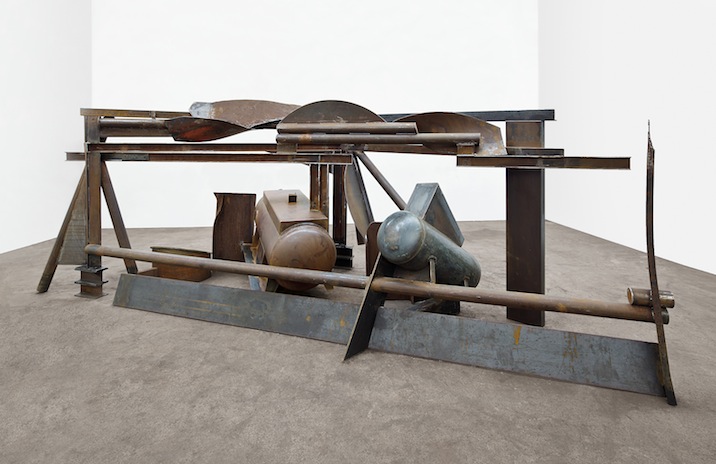Sir Anthony Caro, OM, is wowing them in Venice with his masterly retrospective, but for those of us who can’t get there, there is a generous helping of his characteristic late work in his first show in Gagosian’s airy large gallery. Late Caro (he’s 89, a titan of sculpture) is a revelation in the irresistible vitality with which he imaginatively and consistently finds new things to say using one of his favourite materials: rusted mild steel.
There is a palpable communication of the artist’s own enjoyment, his intelligence and his delight
The 10 constructions are massive and once were envisioned as being even bigger, forming a Caro public sculpture proceeding down New York’s Park Avenue. These sculptures can be thought of in part almost as working sketches for the unrealised project, but are substantial and fully realised works of art in their own right. The sense of working things out and thinking things through is attractive, providing an intriguing insight into the artist’s mind, the same kind of sense of observation, even participation, as is classically provided by drawing.
There is a palpable communication of the artist’s own enjoyment, his intelligence and his delight, as he deploys a vocabulary he has made his own and has used frequently. This is a conversation with industrial scrap and detritus, even if perhaps at times the materials may be custom-made and tailored to order. Caro’s current sculptures are not an assemblage of found elements, even though that is what they may artfully resemble.
But the paradox of Caro, as evidenced in the exquisite mini-retrospective at the Chatsworth estate last year, is that in using industrial materials and even industrial forms, the sculptor can conjure up a magical lightness, a flirtatious choreography. The spaciousness of Gagosian is ideal, as the visitor can easily walk round each piece.
Caro’s early breakthrough was in taking his sculpture off the plinth and putting the work directly on the ground, often with as many as half a dozen resting points. There is no frontal side or back view: all views are valid, and there is no "right" way to look at the work. This is why photographs are peculiarly misleading, and why also that he insists on a human scale by putting his sculptures on the floor. We do not look up to anything, we are on the same level as the work. Caro treats these huge pieces of metal as though he is, in that wonderful phrase of Paul Klee, taking a line for a walk, only in his case a journey into three dimensions.
There are endless permutations in the arrangements and rearrangements of steel beams, rods, planks, sheets, plates, pipes and agricultural tools, some curved, some straight, of varying but nevertheless monumental size. No piece repeats itself, for each piece is phrased differently. Some of the elements touch the floor, others are suspended, still others rest at oblique or straight angles on yet other pieces.
 The notion of choreography is useful. Just as dance uses both the human body, and in classical ballet a specific vocabulary of positions and steps, so too with Caro. And just as contemporary dance takes off from that historical vocabulary, so does Caro use his intense awareness of art history. The totally abstract, hard-edged metallic fragments are welded into a whole, but various relationships suggest characters, even emotions. Although there is nothing that suggests the figurative, the sculptures are curiously animated, even playful, as though they are improbable futuristic machines with lives of their own. Although the elements are fixed and welded together, we can imagine the tantalising possibility that if we turned our back they might slyly, subtly, or even boldly start moving about. And unlike the centuries of sculptural conventions that precede the Caros, they don’t have to come off any pedestals.
The notion of choreography is useful. Just as dance uses both the human body, and in classical ballet a specific vocabulary of positions and steps, so too with Caro. And just as contemporary dance takes off from that historical vocabulary, so does Caro use his intense awareness of art history. The totally abstract, hard-edged metallic fragments are welded into a whole, but various relationships suggest characters, even emotions. Although there is nothing that suggests the figurative, the sculptures are curiously animated, even playful, as though they are improbable futuristic machines with lives of their own. Although the elements are fixed and welded together, we can imagine the tantalising possibility that if we turned our back they might slyly, subtly, or even boldly start moving about. And unlike the centuries of sculptural conventions that precede the Caros, they don’t have to come off any pedestals.
The humanity of these sculptured scrapyards is emphasised by their titles, which enigmatically suggest both natural states and emotions: Torrents, Morning Shadows (main picture), Clouds (pictured above), Towards Morning, Tempest, and perhaps most clearly indicating the human connection, Laughter and Crying. This show is Caro at his most magisterial and his most relaxed, in command of the visual language he has made his own, and playful with it.









![SEX MONEY RACE RELIGION [2016] by Gilbert and George. Installation shot of Gilbert & George 21ST CENTURY PICTURES Hayward Gallery](/sites/default/files/styles/thumbnail_125_x_125_/public/mastimages/Gilbert%20%26%20George_%2021ST%20CENTURY%20PICTURES.%20SEX%20MONEY%20RACE%20RELIGION%20%5B2016%5D.%20Photo_%20Mark%20Blower.%20Courtesy%20of%20the%20Gilbert%20%26%20George%20and%20the%20Hayward%20Gallery._0.jpg?itok=3oW-Y84i)





Add comment